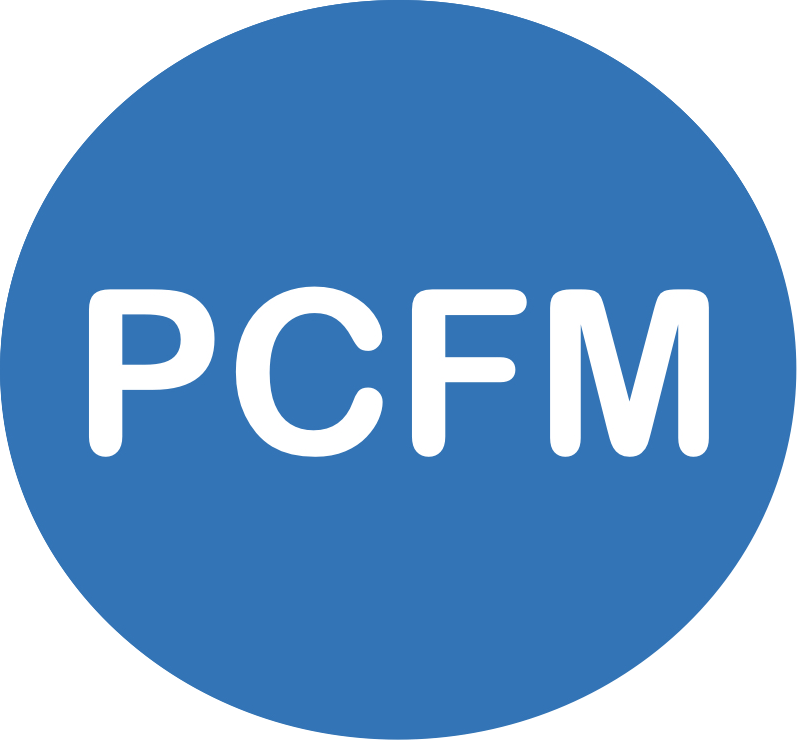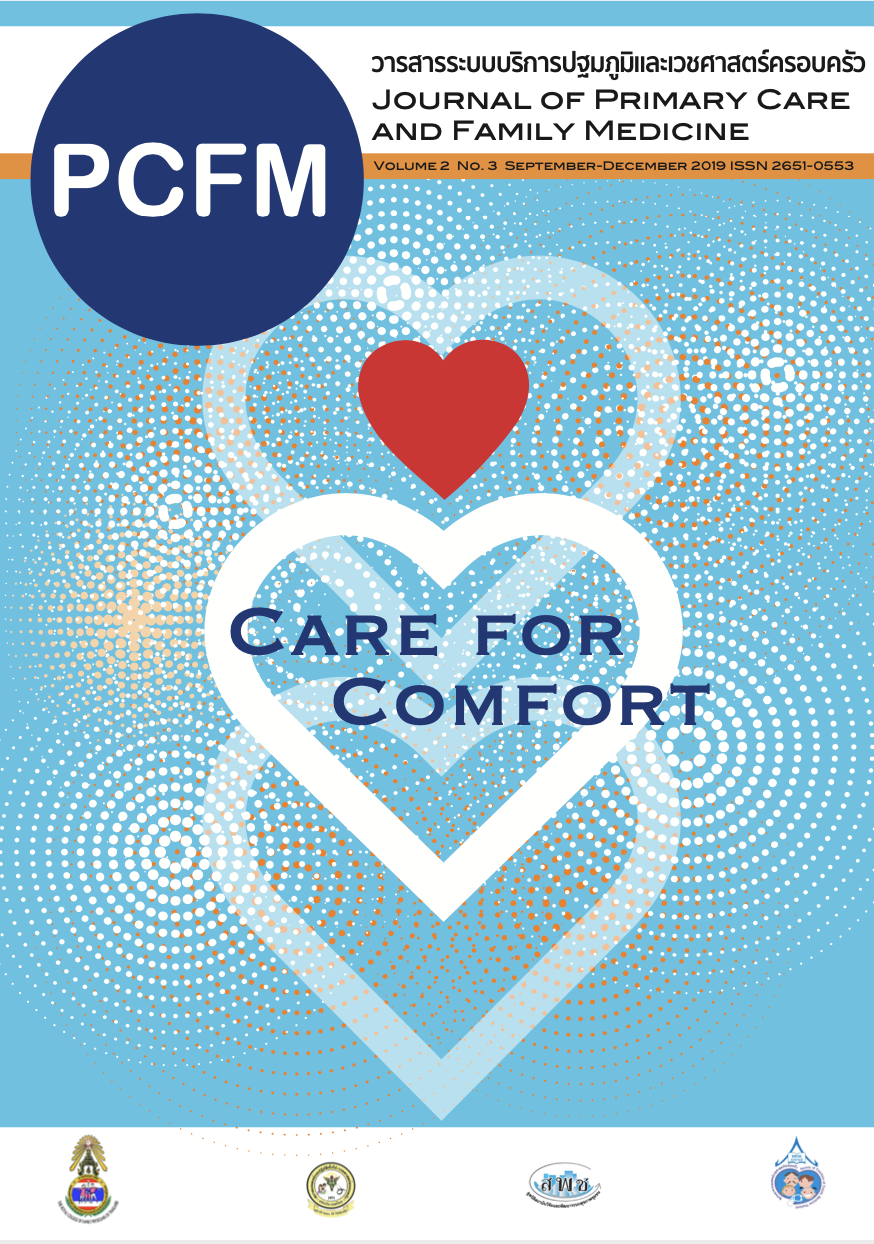อาการและอาการแสดงของภาวะใกล้ตาย
Main Article Content
บทคัดย่อ
อาการและอาการแสดงของภาวะใกล้ตายเป็นสัญญาณเตือนให้แพทย์สื่อสารกับญาติและครอบครัว เพื่อการวางแผนดูแลผู้ป่วยระยะสุดท้ายร่วมกัน หากแพทย์ไม่ตระหนักถึงภาวะใกล้ตายของผู้ป่วย (nearing death awareness) ก็อาจจะไม่สามารถให้การดูแลระยะสุดท้ายที่ดีได้ จึงได้ทบทวนอาการและอาการแสดงของภาวะใกล้ตายโดยการสืบค้นจากฐานข้อมูลPubMed website คู่มือและหนังสือเกี่ยวกับการดูแลประคับประคองและการดูแลผู้ป่วยระยะสุดท้าย พบว่าอาการใกล้ตายที่สำคัญและพบได้บ่อยในการดูแลผู้ป่วยระยะสุดท้ายคือ อาการเหนื่อย อาการปวด อาการเสียงเสมหะก่อนตาย อาการสับสน อาการทั่วไปอื่น ๆ เช่น กินได้น้อย เพลีย ไม่มีแรง ท้องผูก คลื่นไส้และอาเจียน ส่วนอาการแสดงที่เป็นสัญญาณว่าผู้ป่วยกำลังจะตายใน 48-72ชั่วโมงที่สำคัญคือ ความไม่รู้สึกตัว ม่านตาไม่ตอบสนอง การตอบสนองต่อเสียงและภาพลดลง ปิดเปลือกตาไม่สนิท สัญญาณชีพที่เปลี่ยนแปลง เช่น ความดันโลหิตลดต่ำ ชีพจรเร็วขึ้น การหายใจผิดปกติเช่น หายใจไม่สม่ำเสมอ หยุดหายใจเป็นระยะ หายใจแบบ Cheyne Stokes breathing หายใจโดยมีการเคลื่อนไหวของคาง (respiration with mandibular movement) คอเหยียดกว่าปกติ
Article Details
เนื้อหาและข้อมูลในบทความที่ลงตีพิมพ์ในวารสาร PCFM ถือเป็นข้อคิดเห็นและความรับผิดชอบของผู้เขียนบทความโดยตรง ซึ่งกองบรรณาธิการวารสารไม่จำเป็นต้องเห็นด้วยหรือร่วมรับผิดชอบใด ๆ
บทความ ข้อมูล เนื้อหา รูปภาพ ฯลฯ ที่ได้รับการตีพิมพ์ลงในวารสาร PCFM ถือเป็นลิขสิทธิ์ของวารสาร PCFM หากบุคคลหรือหน่วยงานใดต้องการนำทั้งหมดหรือส่วนหนึ่งส่วนใดไปเผยแพร่ต่อหรือเพื่อกระทำการใด ๆ จะต้องได้รับอนุญาตเป็นลายลักษณ์อักษรจากวารสาร PCFM ก่อนเท่านั้น
เอกสารอ้างอิง
2. Brayne S, Fenwick P, Nearing the end of life a guide for relatives and friends of the dying .1st ed .Great Britain: Braynework ;2008.
3. Hui D, Nooruddin Z, Didwaniya N, Dev R, De La Cruz M, Kim SH, et al. Concepts and Definitions for “Actively Dying,” “End of Life,” “Terminally Ill,” “Terminal Care,” and “Transition of Care”: A Systematic Review J Pain Symptom Manage. 2014 Jan; 47(1): 77–89.
4. Kemp C .Terminal Illness: A Guide to Nursing Care.2nd ed Philadelphia:Lippincott Williams & Wilkins;1999
5. Hui D, Moore J, Park M, Liu D, Bruera E.Phase Angle and the Diagnosis of Impending Death in Patients with Advanced Cancer: Preliminary Findings.Oncologist. 2019 Jun;24(6):e365-e373. doi: 10.1634/theoncologist.2018-0288. Epub 2018 Oct 23.
6. Perez-Cruz PE, Dos Santos R, Silva TB, Crovador CS, Nascimento MS, Hall S, et al. Longitudinal temporal and probabilistic prediction of survival in a cohort of patients with advanced cancer .J Pain Symptom Manage. 2014 Nov;48(5):875-82.
7. Singer AE, Meeker D, Teno JM, Lynn J, Lunney JR, Lorenz KA. Symptom trends in the last year of life from 1998 to 2010: a cohort study. Ann Intern Med. 2015 Feb 3;162(3):175-83.
8. Zeng L, Zhang L, Culleton S, Jon F, Holden L, Kwong J, et al. Edmonton symptom assessment scale as a prognosticative indicator in patients with advanced cancer.J Palliat Med. 2011 Mar;14(3):337-42.
9. Ferrell BR, Dean G. The meaning of cancer pain. Semin Oncol Nurs. 1995 Feb;11(1):17-22
10. Pace A, Di Lorenzo C, Guariglia L, Jandolo B, Carapella CM, Pompili A. End of life issues in brain tumor patients. J Neurooncol. 2009 Jan;91(1):39-43.
11. Kehl KA, Kowalkowski JA. A systematic review of the prevalence of signs of impending death and symptoms in the last 2 weeks of life. Am J Hosp Palliat Care. 2013 Sep;30(6):601-16.
12. Doyle D ,Hanks G, Cherny N, Calmanher C K, Oxford Textbook of Palliative Medicine .3rd ed. New York: Oxford University Press;2004
13. Conill C, Verger E, Henríquez I, Saiz N, Espier M, Lugo F, et al. Symptom prevalence in the last week of life. J Pain Symptom Manage. 1997 Dec;14(6):328-31.
14. Mercadante S, Valle A, Porzio G, Aielli F, Adile C, Casuccio A. Prognostic factors of survival in patients with advanced cancer admitted to home care. J Pain Symptom Manage. 2013 Jan;45(1):56-62.
15. Hui D, Dos Santos R, Chisholm G, Bansal S, Souza Crovador C, Bruera E. Bedside clinical signs associated with impending death in patients with advanced cancer: preliminary findings of a prospective, longitudinal cohort study. Cancer. 2015 Mar 15;121(6):960-7.
16. Hui D, dos Santos R, Chisholm G, Bansal S, Silva TB, Kilgore K, et al .Clinical signs of impending death in cancer patients. Oncologist. 2014 Jun;19(6):681-7.
17. Hui D, Hess K, Santos R, Chisholm G, Bruera E. A Diagnostic Model for Impending Death in Cancer Patients: Preliminary Report, Cancer. 2015 November 1; 121(21): 3914–3921.
18. Bruera S, Chisholm G, Dos Santos R, Crovador C, Bruera E, Hui D. Variations in vital signs in the last days of life in patients with advanced cancer. J Pain Symptom Manage. 2014 Oct;48(4):510-7.
19. Ellershaw J ,Wilkinson S .Care of the dying A pathway to excellence. 1st ed. New York .Oxford University Press; 2003
20. Ellershaw J, Smith C, Overill S, Walker SE, Aldridge J. Care of the dying: setting standards for symptom control in the last 48 hours of life. J Pain Symptom Manage. 2001 Jan;21(1):12-7.
21. Hwang IC, Ahn HY, Park SM, Shim JY, Kim KK. Clinical changes in terminally ill cancer patients and death within 48 h: when should we refer patients to a separate room? Support Care Cancer. 2013 Mar;21(3):835-40.
22. Matsunami K, Tomita K, Touge H, Sakai H, Yamasaki A, Shimizu E.Physical Signs and Clinical Findings Before Death in Ill Elderly Patients.Am J Hosp Palliat Care. 2018 Apr;35(4):712-717.
23. Lichter I, Hunt E.The last 48 hours of life. J Palliat Care. 1990 Winter;6(4):7-15
24. Fainsinger R, Miller MJ, Bruera E, Hanson J, Maceachern T. Symptom control during the last week of life on a palliative care unit. J Palliat Care. 1991 Spring;7(1):5-11.
25. Matsunami K, Tomita K, Touge H, Sakai H, Yamasaki A, Shimizu E.Physical Signs and Clinical Findings Before Death in Ill Elderly Patients.Am J Hosp Palliat Care. 2018 Apr;35(4):712-717.
26. Sandvik RK, Selbaek G, Bergh S, Aarsland D, Husebo BS.Signs of Imminent Dying and Change in Symptom Intensity During Pharmacological Treatment in Dying Nursing Home Patients: A Prospective Trajectory Study. J Am Med Dir Assoc. 2016 Sep 1;17(9):821-7.


